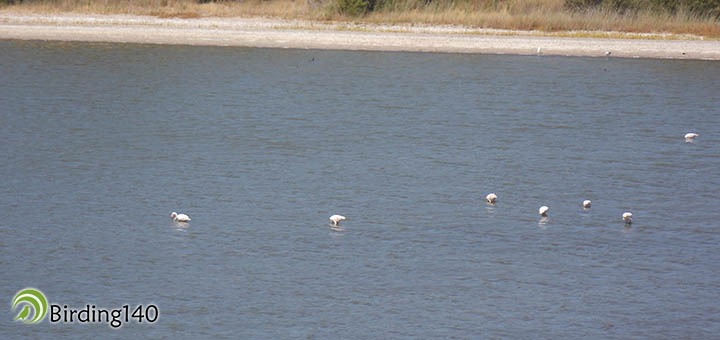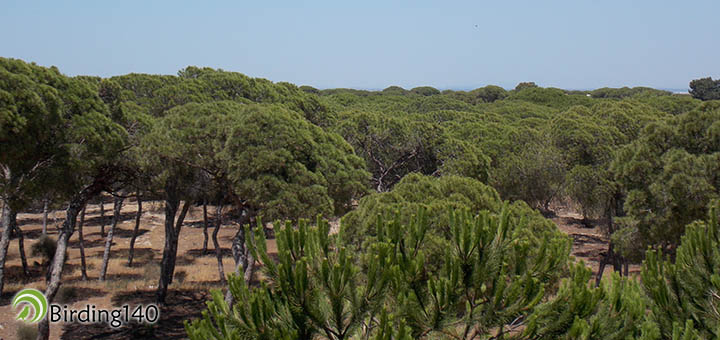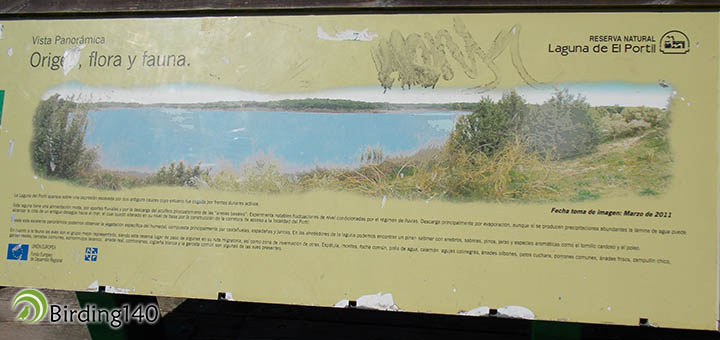The evening falls over the coastal wetland as a small flock of Glossy Ibises flies over at low height. Down in the water, some spoonbills wade in the shore looking for food. The movement of their strange beaks scares a grebe that was resting behind the reed. The little grebe flies away in terror to the other side of the lake, where the undaunted flamingos glance over. Nearby, a couple of crebes talk about love with their water dance. The activity in this natural space makes it an orchard more typical of the African continent than of the old Europe.
And all this happens at down and dusk, every spring and autumn. The feelings produced by the fusion of scents from the plants of the environment are second to none among the variety of colours of its winged tenants. Besides, the surrounding pinewood protects it, lessening its pressure. This is a real corridor for the fugitive birds leaving the nearby Odiel Marshes. As a result, a steady flow of specimens and species arises. Moreover, it is home to flocks of passerines, lonesome Hoopoes and bands of Common Magpies and Azure-winged Magpies tirelessly searching for food. The evening fades away and the last rays of sunlight disappear. After that, it is just darkness and quiet.
This time we are heading to the province of Huelva, in the southeast of Andalusia. From the road that connects Punta Umbría with El Rompido, we access the fresh water lake of El Portil near the residential area of the same name. Only a fence separates the pavement of this strategical bastion, so important for the massive migration of birds from Europe to Africa and vice versa. This constitutes the perfect link of the natural chain that connects Doñana with the Algarve in Portugal. The Natural Area of the Odiel Marshes and the Natural Area of Enebrales de Punta Umbría, as well as the marshlands of Piedras River and Flecha del Rompido are also part of this natural structure. From the viewpoint, we have a panoramic view of the whole perimeter of the lake.
We recommend making the observations from this point, because the rest of the path, except in specific places, does not offer such a clear vision of this space. The sheet of water defined by the reeds, cattail and bulrush looks like a mirror from the air. Birds don’t hesitate to take a rest or spend the night there if necessary. If we look a bit further up, we can see the surrounding pinewood and junipers. This is the starting point of the three kilometre circular path that crosses it. After a wooden bridge we cross from the dunes to the pinewood. The path continues bordering the lake, although it is not visible, up to an old fig orchard. It ends in the houses of the El Portil residential area, beside the golf course “Nuevo Portil”. It is hard to believe that the whole area can be crossed in barely an hour.
The lake was formed by the beds of two old streams that dug out a depression, which was covered by the mobile dunes. They blocked the natural way out to the sea. Its evolution is, therefore, tied to the movement of sand. For this reason this is called a peridunar lake. The fresh water comes from the rain through an aquifer. Its level suffers the logical fluctuations produced by the rainfall conditions and the summer evaporation. Thus, in very dry summers it is at risk of drying out, as has happened sometimes. In 2009, after a very dry period, the lake was on the verge of drying out.
If the reason was the absence of rain or the possible illegal extractions of the aquifer, it was never clear in the mass media. However, the reason of the drought was probably that the aquifer doesn’t have as much pressure as in Doñana. But the surprise arises when we get to know that the sheet of water could reach an old drainage towards the sea, inundating the road that hounds it. Once more, without a doubt, nature shows signs of rebellion against the obstacles set by man.
Most of the birds we can see at the lake come from the Odiel Marshes. However, given that it is a reference point for migratory birds, it is the perfect place to see rarities in spring and autumn. Here it is possible to watch the courtship dance of the Great Crested Grebe, see the seagulls take out the saltpetre, listen to the neigh of the grebes or enjoy a flamingo pink sunset. Little Bitterns, Squacco Herons, Purple Herons and Purple Swamphens, among others, are hidden between the cattails and the reeds. It is surprising how often we can see a Ferruginous Duck and, to a lesser extent, a Red-knobbed Coot and a White-headed Duck.
It is also possible to observe flocks of spoonbills and Glossy Ibis, as well as Black-tailed Godwits, Eurasian Wigeons and Gadwalls. We also believe that the Ferruginous Duck sometimes breeds here after the releases carried out in 1997, although they usually prefer smaller and quieter wetlands.
We therefore ask the administration to protect this wetland, and we ask the users of this area to respect and understand that they are in a unique settlement. We have in our hands the possibility of protecting it for the enjoyment of future generations and, of course, to accommodate the rich birdlife of its waters.
It is surprising that, despite the pressure and the dangers it is subject to, this settlement can have such a capacity to host migratory birds. Among this threats, we can emphasize the residential area itself, which sieves over the reserve. The road that separates it from the sea goes across the border of the water sheet. As if this were not enough, a nearby golf course and the massive arrival of holidaymakers, hikers, cyclist and curious people make the rest in the summer season. This is another example of the force of nature in order to survive the human effort to briquetting and asphalting everything that is close to the coast, without noticing that there are more sustainable ways of bring the beauty of nature close to the human soul.
We would lastly like to say that this post would not have been possible without the invaluable cooperation of Manu Mojarro, great connoisseur and guide of this settlement.















